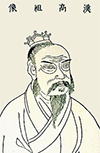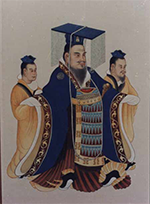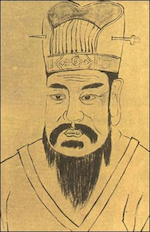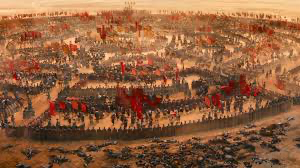China's Han Dynasty
After the death of the first emperor, Shi-huang-di, in 210 B.C., the leaders of China's kingdoms sensed an opportunity to rebel. The empire by then had devolved into more than a dozen territories, and various leaders strove to become the next emperor. The two strongest to emerge were Xiang Yu and Liu Bang, who fought the titanic Battle of Gaixia in 202 B.C. Emerging victorious was Liu Bang, a commoner who had risen to great heights to become the King of Han. He took the name Gaozu and became China's third emperor. This was the beginning of the Han Dynasty. 
The capital city of the Han was Chang'an, which Liu Bang (left) established. Leading to the capital were all major roads. Gaozu inherited a strong governmental apparatus, and he continued his reign in that vein, remembering his upbringing as he lowered taxes on the peasants, those at the bottom of the economic ladder. In exchange, the emperor raised taxes on the powerful, successful merchants, who had benefited from the rich trade that had developed within China's borders and with other civilizations once the first emperor had ended the warring of the kingdoms. 
The united China still had enemies, among them the Xiongnu, a number of people who lived as nomads in the lands to the north and west of China. A Xiongu force defeated the Chinese army in 200 B.C., forcing Liu Bang to send tributes of silk and other expensive goods. Political intrigue continued to complicate orderly succession. Liu Bang died just seven years after becoming emperor. At his death, in 195 B.C., his wife, the empress Lu Zhi, claimed the imperial throne. They had had several sons, and Lu Zhi dispatched some of them. The survivors fought for control for 15 years. Finally, in 180 B.C., Liu Heng (later known as Wen) took control, exacting revenge on his mother's family in the process of taking the throne. Wen ruled for more than two decades of general benevolence, relaxing punishment laws and establishing programs of governmental assistance for needy people. His son Liu Qi (later known as Jing) succeeded him and carried on his policies, including a further reduction in taxes. Emperor Jing did not treat the royal princes equally, and this created a resentment that boiled over into the Rebellion of the Seven States, in 154 B.C. Imperial forces put down the rebellion, and Jing ruled for another 13 years. The latter part of his reign included a controversial imprisonment of the official who had directed the imperial victory during the rebellion. When Jing died, in 141 B.C., his son Liu Che (later known as Wu) succeeded him. 
Many historians consider Wu among China's greatest emperors. He ruled for 54 years and oversaw many significant developments, including the advent of the famous Silk Road, from 138 B.C., and a large territorial expansion, including what is now parts of Korea, Mongolia, and Vietnam. Emperor Wu also, about 135 B.C., restored Confucius to prominence. The Qin emperors had shunned the philosopher's teachings. Wu embarked on a series of reforms to eliminate the favoritism that permeated nearly all levels of government and to increase the power of the throne by weakening the control of various nobles and local officials over things like transportation. The emperor succeeded in his reforms, although it took longer than he thought it would. The struggles against the Xiongnu continued off and on for many years. A Xiongnu army numbering nearly 1 million raided Han China in 126 B.C. Emperor Wu led an army nearly as large in retaliation in 110 B.C. and forced the Xiongnu to retreat. The struggles continued for decades, punctuated by periods of peace and even alliances through intermarriages. During the latter decades of Wu's reign, the emperor adopted more and more the trappings of despotism. Also as he grew older, the emperor grew more and more concerned with extending his life. Some of his predecessors, Shi-huang-di notably among them, had pursued supernatural means of increasing their lifespan. Wu did so as well but was ultimately unsuccessful in these endeavors, dying in 87 B.C. He had declared his youngest son, Liu Fuling, to be his successor, and he took the throne after his father's death. He was later known as Emperor Zhao. During most of the relatively brief period that Zhao was emperor, China had a regent, Huo Guang, in charge. Zhao was 8 when he took the throne and 20 when he died. In the intervening years, the empire was a place of relative peace. The emperor and regent mandated a cut in taxation, and the empire prospered as a result. Huo also triumphed in a struggle with his co-regents, Jin and Shangguan, who briefly sought to put someone else on the throne. Zhao died in 74 B.C. without a son and heir. The ensuing succession crisis ended with the ascension of Zhao's grandnephew, Liu Bingyi, who became Emperor Xuan. Born a prince, Xuan descended to the depths of society when his father died in a failed uprising against Emperor Wu and the baby narrowly escaped death. Rescued by a prison warden, he grew up in that man's family. Emperor Zhao discovered that the young man was still alive and, knowing his heritage, arranged for him to be brought to the palace and educated. He proved a quick study and especially appreciated the teachings of tolerance found in Confucianism. This, coupled with his experiences living as a poor commoner, gave him a strong appreciation for equality, which he maintained as emperor. He took the throne when he was 17. Huo continued as regent to the new emperor for a time and oversaw the empire's ongoing struggles with Xiongnu, which flared up again several times, notably in 71 B.C. Huo died three years after that, and Xuan assumed full power. As emperor in his own right, he continued his policies of tolerance, refusing to order full combat against a handful of rebellious tribes, instead finding a more peaceful solution. He also made a considerable effort to root out corruption in the bureaucratic ranks. In the latter years of his reign, the ongoing threats from the neighboring Xiongnu dissipated and the emperor reduced the size of the army, thereby reducing the taxes needed to support that army, giving his people more money on which to live. He was also known as a proponent of the written word, a relatively new phenomenon. He sponsored a poetry competition at court. Xuan died in 49 B.C. Succeeding him was his son, Crown Prince Shi, who became known as Emperor Yuan. This ruler was far less successful than his father had been at keeping the peace. The new ruler proved indecisive and unable to prevent corruption or in-fighting within the royal court. He did launch a large spending program, designed to improve the lives of his subjects, and he did preside over a long-sought victory over the western Xiongnu. When he died, in 33 B.C., his oldest son, Crown Prince Ao, became Emperor Cheng. During Cheng's 26 years as emperor, he proved unable to stop his land's descent into rebellion and factionalism. He died in 7 B.C. He had no son but named his nephew, Xin, as his heir. He became Emperor Ai. Ai had a brief rule, reigning only six years. He was dominated by his grandmother, the Grand Empress Dowager Fu, who, when Ai died, refused to recognize his successor, his trusted advisor Dong Xian, and instead declared the emperor's cousin Jizi the new ruler; he became Emperor Ping. The new emperor was only 8 and depended on others to run things. The head of the government, Wang Mang, was the nephew of Emperor Yuan's empress, so he had family connections to the ruling clan. He had also married his daughter to the young Emperor Ping. Wang Mang was much trusted by the royal family and accepted the offer to become Emperor Ping's regent. 
Because of the recent spate of childless emperors, people inside the royal court and out suspected that the Han rulers had lost the Mandate of Heaven. Wang Mang (right) acted in several ways to counteract this impression. He brought in scholars to reside at the court and increased the money being paid to royal officials. A turnaround in harvests in A.D. 3 helped buoy public opinion as well. At the same time, Wang Mang consolidated his hold on power by alienating the young emperor from his family, including killing some of them. A power struggle ensued, and the regent came out on top, having poisoned the 13-year-old emperor in A.D. 5. Wang Mang served as acting emperor for three years, overseeing the technical rule of Liu Ying (also known as Ruzi Ying) and then took the throne for himself. Wang Mang declared a new dynasty, the Xin, and made his wife empress. They had four sons and made the younger, Wang Lin, crown prince. Continuing with recent trends, the new emperor populated his court with Confucian scholars. One of the new emperor's first major initiatives was a large land redistribution system. The emperor also abolished slavery, which had been part of the economic system of China since its beginnings. Further consolidating the state's hold on production, the emperor assumed control of a number of things, including fishing, forestry, and the production of liquor, salt, and weapons. One thing that Wang Mang proved unable to stem was a rise in corruption. State officials siphoned off a significant amount of royal revenue, and the emperor lost favor with his people because of the perceived lack of control. A combination of bad harvests and at times oppressive economic policies fomented a number of rebellions, first and foremost in rural areas. A major famine resulting from massive flooding in the Yellow River delta in A.D. 11 contributed mightily to this unrest. Three distant relatives of the previous Han emperors led an uprising against Wang Mang, and a series of battles resulted in a titanic struggle for supremacy. The Han army gained the upper hand and stormed the imperial palace. After a fierce battle, the Han army defeated Wang Mang's personal guard and then killed the emperor. Liu Xuan, as Genshi, proclaimed a new Han dynasty. His rule, too, was short-lived, and a cousin later called Guangwu took the throne. This new emperor consolidated his claim to the throne with a victory in battle over the Red Eyebrows, a group of insurgents who had killed Wang Mang, but still had to fight with other Chinese warlords. Guangwu claimed final victory in 36 and proclaimed a newly united China under the sway of the Han. The ascendancy of Guangwu brought with it also a change in geography. From the beginnings of Han rule through the reign of Wang Mang, the capital was at Chang'an, in the west Guangwu moved his capital Luoyang, in the east. Thus, the first part of the Han Dynasty can be named the Western Han and the second part the Eastern Han. Despite the institution of a number of reforms by Guangwu, the Eastern Han is most well known for its instability, as a series of very young emperors failed to keep control out of the hands of their regents and a few older emperors failed to put the business of government before their own interests. The Five Pecks of Rice Rebellion in 142 was symptomatic of the common people's distrust of the government. At the same time, Chinese armies faced unrest from their neighbors, particularly in what is now Korea and Vietnam. 
The final large-scale rebellion against Han rule came in 184, in the form of the Yellow Turban Rebellion. The Han armies were successful in turning back that challenge; the result, however, was a struggle within the army, as the warlord Cao Cao attempted to declare himself in sole command of the army and the country. He persuaded the then-emperor, Xian, to move the capital to Xuchang in 196. The Battle of Red Cliffs in 208 resulted in the defeat of Cao Cao but the virtual partition of China into, in effect, three kingdoms, Cao Wei, Eastern Wu, and Shu Han. (Many sources refer to this time in Chinese history as the Three Kingdoms Period. Historians officially declare the end of the Han Dynasty as 220. 
The Han period in China is known for its internecine struggles for power. However, this period of time in China was also an expansion of cultural awareness and technological achievements. Among the many firsts for the Chinese civilization was the invention of paper, in 105, by Cai Lun, and the completion of the first dictionary, by Xu Shen, five years earlier. One of the most well-known early books was Sima Qian's The Grand Scribe's Records, a chronicle of China's early rulers. Han advisers also used calendars, sundials, and water clocks to mark the passage of time. Other scientific advancements included the standardization of the water wheel and the invention of a ship's rudder, the seismograph, and a prototypical rotary fan, used for air conditioning buildings. Chinese mathematicians started using negative numbers in their calculations–a first. And the earliest description of a compass dates to this period. Han artists used clay to craft lifelike figurines of animals and people and continued the bronzeworking tradition of their predecessors. Also during this period rose the practice of creating large stone tombs for rulers and other people of importance. In the fine arts came a system of music theory, a system of dance notation, and a cross-genre form of writing known as fu, which combined prose and rhymes. As well, Han engineers crafted the earliest known method of printing with wooden blocks.
|
|
Social Studies for Kids
copyright 2002–2025
David White




